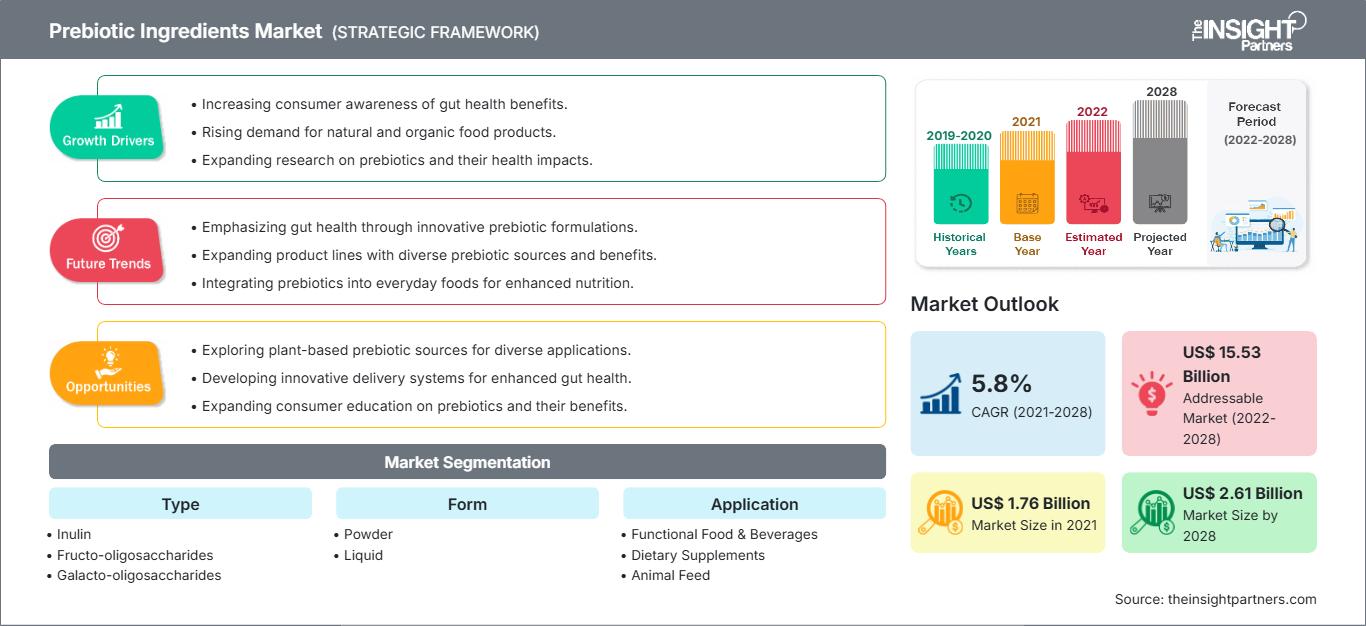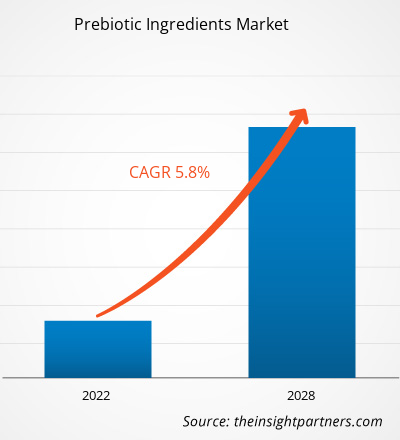[Informe de investigación] Se espera que el mercado de ingredientes prebióticos crezca de US$ 1.758,40 millones en 2021 a US$ 2.607,72 millones en 2028; se espera que crezca a una CAGR del 5,8% de 2022 a 2028.
Los prebióticos son compuestos presentes en los alimentos que inducen el crecimiento o la actividad de microorganismos beneficiosos, como bacterias y hongos. La fermentación es el principal mecanismo de acción mediante el cual las bacterias beneficiosas utilizan los prebióticos en el colon. Los prebióticos desempeñan un papel fundamental en la atención médica preventiva, ya que la creciente popularidad de los suplementos nutracéuticos ricos en fibra entre los deportistas y atletas para aumentar su resistencia y resistencia aumenta aún más la demanda de ingredientes prebióticos. Por lo tanto, la creciente concienciación sobre la atención médica preventiva está impulsando el crecimiento del mercado de ingredientes prebióticos.
Asia Pacífico tuvo la mayor cuota de mercado de ingredientes prebióticos en 2021, mientras que se espera que otras regiones en desarrollo, como Oriente Medio y África, crezcan significativamente durante el período de pronóstico. Este crecimiento del mercado se atribuye al aumento de la salud intestinal y los trastornos inmunitarios, junto con el aumento de las enfermedades digestivas. Los países asiáticos se inclinan por adoptar alimentos y bebidas saludables y nutritivos para mejorar la salud intestinal. Por lo tanto, esta tendencia hacia la adopción de alimentos saludables impulsa el crecimiento del mercado de ingredientes prebióticos.
Obtendrá personalización en cualquier informe, sin cargo, incluidas partes de este informe o análisis a nivel de país, paquete de datos de Excel, así como también grandes ofertas y descuentos para empresas emergentes y universidades.
Mercado de ingredientes prebióticos: perspectivas estratégicas

- Obtenga las principales tendencias clave del mercado de este informe.Esta muestra GRATUITA incluirá análisis de datos, desde tendencias del mercado hasta estimaciones y pronósticos.
Impacto de la pandemia de COVID-19 en el mercado de ingredientes prebióticos
La pandemia de COVID-19 planteó desafíos sin precedentes para muchos sectores a principios de 2020. Los confinamientos, las restricciones fronterizas, las prohibiciones de viaje, la interrupción de la fabricación y otras medidas de seguridad implementadas por los gobiernos según las directrices de la OMS y los ministerios de salud nacionales obstaculizaron las operaciones de fabricación. Sin embargo, el brote de COVID-19 tuvo un impacto positivo en el mercado, ya que los consumidores buscaban cada vez más alternativas naturales y seguras para mantenerse sanos y fortalecer su sistema inmunitario. La demanda de suplementos dietéticos aumentó drásticamente durante los primeros meses de la pandemia. Además, al confinarse en casa debido a las órdenes gubernamentales, las personas se centraron en su salud y bienestar, lo que impulsó la demanda de prebióticos durante la pandemia.
Perspectivas del mercado
Creciente demanda de ingredientes prebióticos en el sector de alimentos y bebidas
La popularidad de los prebióticos está aumentando en la industria de alimentos y bebidas debido a su aplicación en barras nutricionales, productos lácteos, bebidas saludables, suplementos minerales, cereales para el desayuno, productos de panadería, confitería, alimentos verdes y fórmulas infantiles. En noviembre de 2018, la compañía Kellogg lanzó un nuevo cereal, bajo la marca HI! Happy Inside, que incluye prebióticos y probióticos, como parte de su línea de productos digestivos que estimulan el intestino. Además, la inulina se utiliza ampliamente en el procesamiento de alimentos, ya que es un sustituto bueno y saludable de la grasa y el azúcar. Los principales países productores de leche, como EE. UU., India y China, utilizan prebióticos para proporcionar la textura deseada a los productos finales y elaborar productos lácteos sin azúcar. Además, la fórmula infantil o los alimentos para bebés contienen varios ingredientes prebióticos, incluidos los galactooligosacáridos, los fructooligosacáridos y la polidextrosa. Estos son los factores que impulsan el crecimiento del mercado de ingredientes prebióticos.
Perspectivas basadas en tipos
Según el tipo, el mercado de ingredientes prebióticos se segmenta en inulina, fructooligosacáridos (FOS), galactooligosacáridos (GOS), mananooligosacáridos (MOS) y otros. Se proyecta que el segmento de la inulina registre la mayor participación durante el período de pronóstico. Los fabricantes la utilizan en alimentos y bebidas procesados, suplementos dietéticos y piensos para animales para sustituir el azúcar, la grasa y la harina. En Estados Unidos, en 2018, la Administración de Alimentos y Medicamentos (FDA) aprobó la inulina como ingrediente de fibra dietética para mejorar el valor nutricional de los productos alimenticios manufacturados. Además, la creciente demanda de productos naturales incrementa la demanda de inulina prebiótica a nivel mundial. El crecimiento del segmento de la inulina se debe a su creciente aplicación en diversas industrias, lo que impulsa el crecimiento del mercado de ingredientes prebióticos.
Información basada en formularios
Según su presentación, el mercado de ingredientes prebióticos se segmenta en polvo y líquido. Se proyecta que el segmento de polvo registre una mayor tasa de crecimiento anual compuesta (TCAC) durante el período de pronóstico. El polvo facilitó la distribución y el consumo de prebióticos. El uso de prebióticos en polvo para la producción ganadera ha ganado popularidad, ya que estos prebióticos se pueden consumir en cualquier etapa de la vida del ganado. Además, la creciente productividad de carne, huevos y leche incrementa la demanda de prebióticos en polvo.
Perspectivas basadas en aplicaciones
Según su aplicación, el mercado de ingredientes prebióticos se segmenta en alimentos y bebidas funcionales, suplementos dietéticos, piensos para animales y otros. Se proyecta que el segmento de suplementos dietéticos registre la tasa de crecimiento anual compuesta (TCAC) más alta del mercado durante el período de pronóstico. La creciente demanda de medicamentos preventivos, el creciente número de enfermedades digestivas en la tercera edad y la falta de una dieta equilibrada probablemente incrementarán la demanda de productos en la industria de suplementos dietéticos. Los consumidores prefieren cada vez más los suplementos alimenticios a base de prebióticos debido a la creciente adopción de dietas poco saludables.
Las empresas clave que operan en el mercado de ingredientes prebióticos son BENEO GmbH; COSUCRA; DuPont Nutrition & Biosciences; Clasado Ltd.; Nexira; Ingredion Incorporated; SOLACTIS; Cargill, Incorporated; Sensus; y Roquette Frères. Estas empresas se dedican al desarrollo de productos con riesgos reducidos para la salud para satisfacer las nuevas tendencias de consumo y cumplir con los marcos regulatorios. Participan en fusiones y adquisiciones, expansiones comerciales y alianzas para ampliar su cuota de mercado.
Perspectivas regionales del mercado de ingredientes prebióticos
Los analistas de The Insight Partners han explicado detalladamente las tendencias regionales y los factores que influyen en el mercado de ingredientes prebióticos durante el período de pronóstico. Esta sección también analiza los segmentos y la geografía del mercado de ingredientes prebióticos en América del Norte, Europa, Asia Pacífico, Oriente Medio y África, y América del Sur y Central.
Alcance del informe de mercado de ingredientes prebióticos
| Atributo del informe | Detalles |
|---|---|
| Tamaño del mercado en 2021 | 1.760 millones de dólares estadounidenses |
| Tamaño del mercado en 2028 | US$ 2.61 mil millones |
| CAGR global (2021-2028) | 5,8% |
| Datos históricos | 2019-2020 |
| Período de pronóstico | 2022-2028 |
| Segmentos cubiertos | Por tipo
|
| Regiones y países cubiertos | América del norte
|
| Líderes del mercado y perfiles de empresas clave |
|
Densidad de actores del mercado de ingredientes prebióticos: comprensión de su impacto en la dinámica empresarial
El mercado de ingredientes prebióticos está creciendo rápidamente, impulsado por la creciente demanda del usuario final debido a factores como la evolución de las preferencias de los consumidores, los avances tecnológicos y un mayor conocimiento de los beneficios del producto. A medida que aumenta la demanda, las empresas amplían su oferta, innovan para satisfacer las necesidades de los consumidores y aprovechan las tendencias emergentes, lo que impulsa aún más el crecimiento del mercado.

- Obtenga una descripción general de los principales actores clave del mercado de ingredientes prebióticos
Informe destacado
- Tendencias progresivas de la industria en el mercado de ingredientes prebióticos para ayudar a los actores a desarrollar estrategias efectivas a largo plazo.
- Estrategias de crecimiento empresarial adoptadas para asegurar el crecimiento en mercados desarrollados y en desarrollo
- Análisis cuantitativo del mercado de ingredientes prebióticos de 2022 a 2028
- Estimación de la demanda mundial de probióticos
- Análisis de las cinco fuerzas de Porter para ilustrar la eficacia de los compradores y proveedores que operan en la industria
- Desarrollos recientes para comprender el escenario del mercado competitivo
- Tendencias y perspectivas del mercado y factores que rigen el crecimiento del mercado de ingredientes prebióticos
- Asistencia en el proceso de toma de decisiones destacando las estrategias de mercado que sustentan el interés comercial, lo que conduce al crecimiento del mercado.
- Tamaño del mercado de ingredientes prebióticos en varios nodos
- Descripción detallada y segmentación del mercado y la dinámica de la industria de los probióticos.
- Tamaño del crecimiento en varias regiones con oportunidades de crecimiento prometedoras
- Análisis histórico (2 años), año base, pronóstico (7 años) con CAGR
- Análisis PEST y FODA
- Tamaño del mercado, valor/volumen: global, regional y nacional
- Industria y panorama competitivo
- Conjunto de datos de Excel
Informes recientes
Informes relacionados
Testimonios
Razón para comprar
- Toma de decisiones informada
- Comprensión de la dinámica del mercado
- Análisis competitivo
- Información sobre clientes
- Pronósticos del mercado
- Mitigación de riesgos
- Planificación estratégica
- Justificación de la inversión
- Identificación de mercados emergentes
- Mejora de las estrategias de marketing
- Impulso de la eficiencia operativa
- Alineación con las tendencias regulatorias






















 Obtenga una muestra gratuita para - Mercado de ingredientes prebióticos
Obtenga una muestra gratuita para - Mercado de ingredientes prebióticos